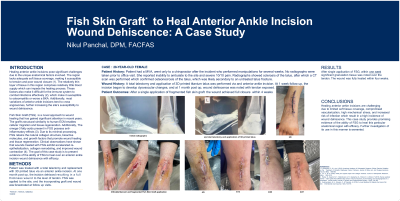Case Series/Study
(CS-111) Fish Skin Graft to Heal Anterior Ankle Incision Wound Dehiscence

Healing anterior ankle incisions pose significant challenges due to the unique anatomical factors involved. The region lacks adequate soft tissue coverage, making it susceptible to tension and poor wound closure (1). The relatively thin layer of tissue in this region comprises blood supply which can impede the healing process. These factors also make it difficult for the immune system to combat infections effectively (2), which make it susceptible to osteomyelitis or worse a BKA. Fish Skin Graft (FSG)* is a novel approach to wound healing that has gained significant attention in recent years. The graft's structural similarity to human ECM enables cellular migration and tissue regeneration. Additionally, the omega-3 fatty acids present in FSG possess anti-inflammatory effects (3). Due to its minimal processing, FSG retains the natural collagen structure, bioactive molecules, and growth factors that promote wound healing and tissue regeneration. Clinical observations have shown that wounds treated with FSG exhibit accelerated re-epithelialization, collagen remodeling, and improved wound contraction (4). The goal of this case study is to present evidence of the ability of FSG to heal over an anterior ankle incision with efficacy.
Methods: Patient was treated with a total talectomy and replacement with 3D printed talus via an anterior ankle incision. The incision dehisced completely to the level of tendon. FSG was applied to the site, the incorporating graft and wound was fenestrated at follow up visits.
Results: After single application of FSG, within a week significant granulation tissue was noted over the tendon. The wound was fully healed at four weeks.
Discussion: Healing anterior ankle incisions are challenging due to limited soft tissue coverage, compromised vascularization, high mechanical stress, and increased risk of infection which result in a high incidence of wound dehiscence. This case study provides promising evidence of the ability of FSG to heal these incisions with efficacy. Further investigation of its use in this region is warranted.
Trademarked Items:
References: 1. DiGiovanni, C. W., et al. (2016). American Academy of Orthopaedic Surgeons Clinical Practice Guideline on the Treatment of Pediatric Diaphyseal Femur Fractures. Journal of Bone and Joint Surgery-American Volume, 98(8), 688-695.
2. Ye, X., et al. (2018). Ankle joint capsule repair with collagen matrices. Journal of Orthopaedic Research, 36(4), 1205-1213.
3. Rieder, E., Kasimir, M. T., Silberhumer, G. R., Seebacher, G., Wolner, E., & Simon, P. (2019). Human acellular dermal matrix grafts from different skin donors: Immune response, wound healing, and neoangiogenesis in a humanized mouse model. Journal of Thoracic and Cardiovascular Surgery, 118(2), 314-320.
4. Gudmundsson, G. H., Árnason, F., & Theodors, A. (2016). A novel treatment for diabetic foot ulcers: fish skin. International wound journal, 13(5), 733-741.

.png)